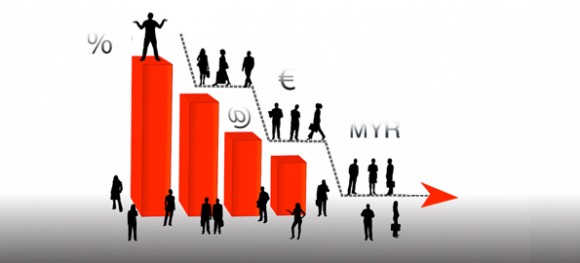MALAYSIA’s once rosy economic outlook isn’t looking as rose petal-fresh as it used to anymore. In 1992, Malaysia transitioned from a lower-middle to upper-middle income country, surpassing most of our regional neighbours. Rich in natural resources and attractive to global investors due to relatively low production costs, Malaysia prospered in the early 1990s. But other regional low-cost centres have since emerged, rendering Malaysia less competitive. At the same time, petroleum revenues, which have funded large sectors of the nation’s growth, will deplete in the near future.

In December 2009, Second Finance Minister Datuk Seri Ahmad Husni Hanadzlah acknowledged Malaysia’s loss of competitiveness and decade-long economic stagnation. “Malaysia is trapped in a low-value-added, low wage and low productivity structure,” he said. Unlike former compatriots South Korea, Singapore and Hong Kong which have all progressed, Malaysia is still elusively seeking to escape the middle-income trap.
So, what’s been holding us back? And what will it take to move us up the value chain? Will the recently revealed 10th Malaysia Plan (10MP) truly “power the economy into First World status” as newspaper headlines declared?
What went wrong?
National Economic Advisory Council (NEAC) member and London School of Economics economics department head Professor Dr Danny Quah says Malaysia’s natural resources may have lulled us into complacency, resulting in a significant deterioration in global competitiveness.
“Many other economies in the region have been much more sensitive to and sensible about the changes needed to lead,” Quah tells The Nut Graph in an e-mail interview from London. “Malaysia’s natural wealth has allowed it to indulge instead.”

He says Malaysia is not the only country to suffer from the “natural resource curse” – where an initial abundance of wealth leads to underperformance.
Quah says 40% of government spending is currently paid for by petroleum revenues, which would dry up by 2014. And 20% of government spending goes towards subsidies alone. In response to a reference to the recent “Are we going bankrupt?” controversy, Quah says, “Controversy? Hardly a controversy, it’s just arithmetic.”
Universiti Malaya political economist Professor Dr Terence Gomez cites several other reasons why Malaysia is still stuck in the middle. A “paltry amount of investments in research and development,” is one of the factors. A “serious deterioration in the quality of education from primary right up to tertiary level”, is another.
Gomez says there also needs to be an improvement to the public delivery system as a whole in a public sector seen to be inefficient and highly bloated.
So if the system is broken, or perhaps not functioning as well as it should, then how do we fix it?
10MP & NEM
Enter the 10MP that is intended to chart Malaysia’s economic growth path for the next five years. The 10MP was highly anticipated, coming three months after Prime Minister Datuk Seri Najib Razak’s unveiling of the NEAC’s New Economic Model (NEM), which Gomez says is an “honest document”.
The NEM made clear that “Vision 2020 is not possible without economic, social and government transformation” which was “urgent” and “radical”. It proposed market-friendly affirmative action measures, focusing on the bottom 40% of low-income households. This prompted speculation, and perhaps hope, in some quarters that the government would move away from distortionary, race-based affirmative action policies.
However, Centre for Policy Initiatives director Dr Lim Teck Ghee says the NEM’s fine principles have not been translated into concrete programmes and deliverables in the 10MP. “I’ve searched in vain so far for strong evidence that the NEM’s principles are deeply embedded in it,” he says in an e-mail interview.
Moreover, the 10MP’s key strategies, on bumiputera corporate equity ownership, for example, may contradict the NEM. “It looks like most of the NEM will end up as platitudes and high-sounding rhetoric as it is not backed up by actual projects, strategies and budgets in the 10MP,” Lim notes.

Gomez agrees that the 10MP does not take the “bull by the horns” in dealing with the serious structural problems the government is now facing.
When asked whether the re-emphasis on bumiputera corporate equity ownership in the 10MP contradicts the NEM’s principles, Quah disagrees. He says the 10MP only describes bumiputera corporate equity ownership at an aggregate Malaysian economy-wide level. He adds that the 10MP does not apply ownership restrictions to every business entity. He says hence, bumiputera corporate equity ownership can perhaps be satisfied with a few, large, wholly-owned bumiputera corporations, as envisioned in the 10MP. The rest of the corporate landscape would be free from further ownership restrictions.
Denial?
Najib paints a rosy picture in his 10MP speech, talking about falling fiscal deficits and sustainable and inclusive growth. But to achieve the 10MP’s targets, Malaysia’s economy needs to grow by 6% annually.

Malaysian Institute of Economic Research distinguished fellow, Emeritus Professor Datuk Dr Mohamed Ariff, says there are indications the government is in denial about the growth rates Malaysia can achieve. “[The government] has been totally misled by the double-digit growth in the first quarter of 2010,” he says. “The government attributes this dramatic turnaround to its own policies, but the facts show the rebound was largely attributed to an export surge in the first quarter — a regional trend. The double-digit growth was also attributable to the low base value a year ago which will wear off in subsequent quarters.”
Ariff says the 6% growth projection is based on the assumption that private investment will grow at 12.8%. But he says from 2006 to 2009, the private investment growth rate was only 2%.
Lim says Malaysia’s economic success is also hinged on the state of the global economy which remains doubtful. Ariff echoes this point, noting notes that a double-dip recovery is still a distinct possibility.
The way forward
Despite the challenges, Ariff says Malaysia is still one of the better economies in the region, with strong macroeconomic fundamentals. But changes will be needed if we are to continue competing globally and maintaining or improving our living standards.
Quah says a lot will depend on the actions of all Malaysians, not just government policy. While acknowledging the damage caused by corruption and mismanagement at all governmental levels, he says millions of Malaysians must also overcome their “deadly addiction” to subsidies.

Lim, however, says removing subsidies will especially hurt the lower- and middle-class, while the 10MP provides subsidies for the rich through “public-private partnerships, mega-projects, and the extension of bumiputera policies to all other sectors.”
But Quah says ultimately, measures that result in economic growth would bring benefits for everyone. “What different groups want or need… will not be possible if Malaysia does not become competitive and successful as a high-growth macro-economy,” he says.
In other words, any measures that propel us towards being a high-income economy will be beneficial to all, even if painful and controversial in the short-term. But will our government be clear-minded and courageous enough to communicate this message to all Malaysians? ![]()
The Nut Graph needs your support


Jacqueline Ann Surin says
Seems to me that we’re actually in quite a dire situation. What is needed, it would seem, is urgent action. Rather, what we’re seeing is denial on the part of the BN government, and the continuing pandering to political interests.
I mean, which prime minister would distance his/her administration from the NEAC and its recommendations? The NEAC, after all, was set up by the government, no less, to be its advisor in times of economic uncertainty. Why doesn’t the 10MP reflect the recommendations of the NEAC?
Any other responsible government would by now be taking drastic measures to address the bleak economic outlook that will soon come upon us. Instead, we have a government that is too scared of losing power and not scared enough for this country’s economic survival.